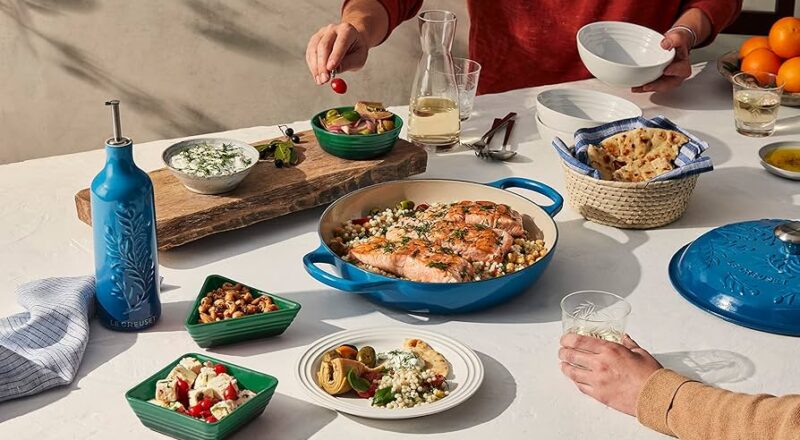For kitchen professionals and home cooks alike, understanding how to use a cast iron braiser can elevate your culinary skills to new heights. The versatility of a cast iron braiser makes it an essential tool for anyone serious about cooking. Whether you’re searing, braising, or simmering, this cookware can handle it all. In this article, we will explore the numerous ways to utilize a cast iron braiser, ensuring you make the most of this incredible kitchen asset.

What is a Cast Iron Braiser?
A cast iron braiser is a round or oval pan with a heavy, tight-fitting lid. It typically has two side handles for easy lifting. The design is perfect for slow-cooking meats, vegetables, and other ingredients, allowing flavors to meld beautifully. The robust nature of cast iron ensures even heat distribution, making it ideal for a variety of cooking methods.
Benefits of Using a Cast Iron Braiser
One of the primary advantages of a cast iron braiser is its ability to retain heat. This feature is crucial for maintaining consistent cooking temperatures, which is essential for braising. The material also allows for excellent browning, adding depth to your dishes. Additionally, cast iron is incredibly durable, often lasting for generations with proper care.
Heat Retention
The thick walls of a cast iron braiser are perfect for retaining heat, which is vital for slow-cooking processes. This quality ensures that meals are cooked evenly throughout, avoiding hot spots that can lead to uneven cooking.
Durability
When cared for properly, a cast iron braiser can last a lifetime. Unlike other materials that may warp or degrade over time, cast iron remains steadfast, providing consistent performance.
Steps to Using a Cast Iron Braiser
Using a cast iron braiser effectively involves several key steps. By following these guidelines, you can ensure optimal results every time you cook.
Selecting the Right Ingredients
Choosing the right ingredients is crucial when using a cast iron braiser. Opt for cuts of meat that benefit from slow cooking, such as chuck roast or pork shoulder. Vegetables like carrots, onions, and potatoes are excellent choices as they absorb flavors well.
Preheating the Braiser
Preheat your braiser on the stovetop over medium heat. This step is important to ensure that the pan is evenly heated, which helps in achieving a perfect sear on meats.
Searing the Meat
Before braising, sear the meat on all sides. This process locks in juices and creates a savory crust that enhances the overall flavor of the dish.
Adding Liquid
Once the meat is seared, add your choice of liquid. This could be broth, wine, or water, depending on the recipe. The liquid should come halfway up the sides of the meat.
Braising
Cover the braiser with its lid and transfer it to a preheated oven. The low and slow cooking method at around 300F (150C) allows the meat to become tender and flavorful.
Cleaning and Maintaining Your Braiser
Proper maintenance of your cast iron braiser is essential to ensure its longevity and performance. Always wash it by hand with mild soap and water. Avoid using abrasive sponges that can damage the seasoning.
Seasoning the Braiser
To maintain the seasoning, apply a thin layer of vegetable oil to the inside of the braiser after cleaning. This step helps to protect the cast iron from rusting and keeps it non-stick.
Storing Your Braiser
Store your braiser in a dry place. If stacking other pots and pans on top, consider placing a paper towel inside to protect the surface.
For more detailed cleaning instructions, check out Cast Iron Seasoning.
Cooking Tips and Tricks
To enhance your cooking experience with a cast iron braiser, consider these tips:
Use Low Heat
Cast iron retains heat well, so cooking on low heat is often sufficient. This technique prevents burning and allows flavors to develop fully.
Experiment with Flavors
Don’t be afraid to experiment with different herbs and spices. The braiser’s design allows these flavors to infuse into your dish beautifully.
Explore more recipes and techniques at Le Creuset’s Guide.
Common Mistakes to Avoid
While using a cast iron braiser is relatively straightforward, there are common mistakes to avoid:
Overcrowding the Pan
Ensure there is enough space between ingredients to allow for even cooking. Overcrowding can lead to steaming rather than searing.
Skipping the Preheat
Never skip preheating your braiser. This step is crucial for achieving the perfect texture and flavor.

FAQs
What can be cooked in a cast iron braiser?
A variety of dishes such as stews, roasts, and casseroles can be cooked in a cast iron braiser.
Can a braiser be used on an induction cooktop?
Yes, a cast iron braiser can be used on an induction cooktop. For more information, visit Induction Guide.
How do I prevent my braiser from rusting?
Keep your braiser well-seasoned and dry after each use to prevent rusting.
With these insights and tips, you’re now ready to master the art of using a cast iron braiser. Embrace this versatile cookware and create meals that are both flavorful and memorable.
This article contains affiliate links. We may earn a commission at no extra cost to you.

